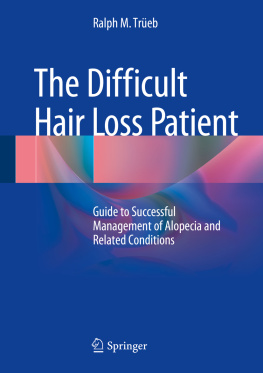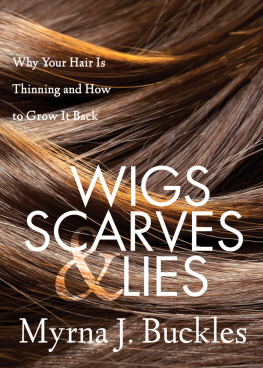By definition, a myth is either a traditional sacred story, typically revolving around the activities of gods and heroes, which purports to explain a natural phenomenon or cultural practice, or a fiction or half-truth, especially one that forms part of an ideology. With reference to the myths relating to the condition of our hair, a distinction can be made between the historical myths, the popular or laymans myths, and the physicians myths. At the end of the book, we will turn to the religious myth.
1.1 Historical Myths: Experiments on Hair Loss Cures
As early as can be traced in history, written documents testify endeavors shown by humanity to please by means of the hair. The literature on hair is almost as vast as the myths, legends, and superstitions that flourished around it. From the 4,000-year-old medical papyri of the ancient Egyptians, throughout Greek and Roman civilization down to modern times, human hair growth and color have been the object of superstition and mystery as well as cosmetic and medical interest.
For prevention or treatment of hair loss, countless herbal solutions, oils, lotions, magic pills, and even spiritual invocations have been advanced with questionable result. With the advance of medical technologies, ultraviolet light-emitting lamps, electrical scalp stimulators, and vacuum-cap machines have all been alleged to help stimulate the follicles to grow hair.
What is remarkable about the history of hair loss cures is that despite the more recent genuine advances in effective medical treatments, hair cosmetics, and surgical procedures, phony hair loss solutions continue to be marketed today with an amazing success. Despite their outrageous claims, most lack scientifically measurable efficacy in preventing hair loss or promoting hair growth. But people are so concerned about their hair loss; they want to believe some miracle cure or some charismatic healer will help them.
In ancient Egypt treatment of the scalp obtained much attention.
One of the oldest medical specialties, according to Herodotus (490/480424 BC), was the Egyptian physician of the head ( ) who specialized in affections of the scalp.
Among the earliest forms of hair cosmetic procedures were hair setting by the use of beeswax, letting it dry exposing the head to the sun, until it hardened, and hair coloring with henna ( Lawsonia inermis ) and indigo ( Indigofera tinctoria ). Ancient Egyptians used to wash their hair regularly with a mix of water and citric juices. They used almond oil as a conditioner after washing the head. The hair results smooth and brilliant. Rosemary oil and castor oil were used to strengthen the hair. Finally, elaborately arranged hair or an ornamental wig was part of the toilet of a woman hoping to engage in love. Hair, whether natural or artificial, was intended to invoke male recognition of feminine appeal and desirability.
Besides the numerous prescriptions for beautification of the scalp, the Papyrus Ebers, Smith, and Hearst embody an abundant Dreckapotheke of remedies for prevention or treatment of alopecia. Most of these were accompanied by elaborate exorcisms. The Papyrus Ebers, discovered in Luxor, Egypt, probably includes medical information drawn from the earlier described compendium of medical knowledge which was collected yet another 2,000 years earlier. It is the oldest complete medical text ever found, and it includes a written prescription for treating baldness: a mixture of iron oxide, red lead, onions, alabaster, honey, and fat from a variety of animals including snakes, crocodiles, hippopotamuses, and lions. The mixture was to be swallowed, after first reciting magical invocations to the sun god.
In ancient Greece, Hippocrates (460370 BC), whom we consider the father of Western medicine, tried many medical solutions for his own progressive hair loss. One of his medical formulas was a mixture of opium, horseradish, pigeon droppings, beetroot, and various spices that were applied to the head. Nevertheless, Hippocrates himself eventually lost his hair to the extent that today we still refer to androgenetic hair loss as Hippocratic baldness . In his collection of observations called the Aphorisms of Hippocrates , he noted that Persian army eunuchs guarding the kings harem never experienced hair loss. He noticed that virile hot-blooded men went bald, but since eunuchs were castrated, they lacked hot blood and therefore retained their hair. On the same line, Greek philosopher Aristotle (384322 BC) noted that women do not go bald, because their nature is akin to eunuchs and children. Aristotle himself recommended goats urine to cure baldness.
In ancient Rome, abundant hair symbolized power. This presented a problem for Julius Caesar himself, since his hairline was gradually receding. First, he began growing it long in the back and combing it straightforward over his bald spot. Soon he took to wearing a laurel wreath around his head to hide his hair loss. The trademark wreath soon became a symbol of power. Caesars protge and consort, Egyptian Queen Cleopatra (6930 BC), concocted a mixture of ground horse teeth and deer marrow to help out Julius Caesars receding hairline. She did this to save her beloved from being ridiculed since his name Caesar means head of hair in Latin.
Roman women originally dressed their hair with great simplicity. One of the simplest styles of wearing the hair was allowing it to fall down in tresses behind and only confining it by a band encircling the head. Another popular but simple hairstyle was platting the hair and then fastening it behind with a large pin. During the reign of Emperor Augustus (63 BC14 AD), a variety of different and elaborate hairstyles came into fashion, and eventually, during the Flavian Dynasty (6996 AD), hairstyles were raised to a great height by rows of false curls. In addition, wigs and hair pieces were used to create an illusion of abundant locks. When Julius Caesar (10044 BC) triumphantly returned to Rome from the Gallic wars bringing with him captive blond-haired female Gauls, there was much enthusiasm for their blond hair among the brunette women of Rome. Though the aristocratic Roman ladies scorned the captives as pictae (painted women), indeed, they came to fashion wigs from their hair. Later they took to bleaching their hair with pomades composed of beech ashes and the tallow from natural goat fat.
Byzantium represents the natural continuation of the GrecoRoman civilization from the time Constantine the Great (272337) transferred the capital of the Roman Empire to Constantinople in 324, until 1453, when it fell to the Ottomans. Byzantium was not only a religious state of holy men; it had a bustling social life with the Byzantine ladies paying special attention to their appearance. A typical example is that of Empress Zoe Porphyrogenita (9781050). Although she was 50 when she first married, despite her age, she married twice more. With typical Byzantine ingenuity, she had many rooms in her chambers converted into laboratories for the preparation of secret ointments for beautification. The vanity and desire for beauty of the Byzantine ladies was given the attention of the Byzantine physicians, the majority of whom had acquired their knowledge of earlier medical texts of Hippocratic, Hellenistic, and Roman times in Alexandria, enriching this material with personal experience. The Byzantine physicians dealt especially with the specialty of dermatology and paid special attention also to the topic of cosmetics, including the condition and color of the hair.







